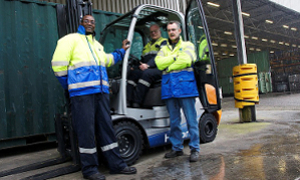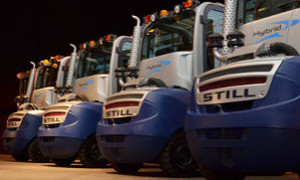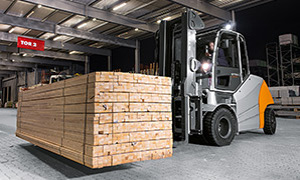The Right Combination
Example: RX 70 - Tested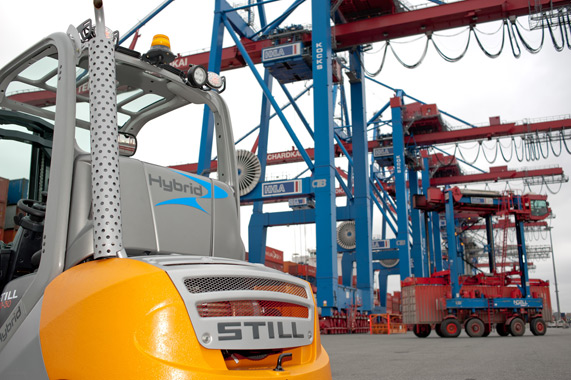
Example: RX 70 - Tested by f+h
Test: What are the benefits of acquiring a hybrid forklift or, more precisely, a engine driven truck with hybrid technology? Manufacturers of industrial trucks often emphasize low fuel consumption, the reduction of CO2 emissions and lowered service and maintenance times and expense as the greatest advantages. Testing shows, with these promises in mind, how the STILL RX70-30 Hybrid compares.
The RX 70 is a serial hybrid in which an engine drives a generator which, in turn, provides the truck with the electrical energy that is needed to complete the truck's work. A concept which allowed for the omission of a great many mechanical or hydraulic components and let the engine truck achieve the handling characteristics of an electric truck. However, it has until now been impossible - in contrast to purely electrically driven trucks - to truly utilize the energy gained during the braking process. Super capacitors (super caps) in the new RX70 Hybrid series trucks now make this possible and efficient. The use of these capacitors partially makes the RX70-30 Hybrid into a parallel hybrid: the lift does not, in fact, have a purely electric drive, but does use the available 8 kw of electrical energy alongside the engine's output (30 kW). Because of the electrical power of 8 kw (which comes, according to STILL, from the super caps) the truck can be equipped with a smaller engine making it more economical to operate. The forklift manufacturer states in its brochures that this leads to savings of ten percent. We were able to visit STILL's testing site in Hamburg and see for ourselves whether this claim is in fact true.
Productivity Put to the Test
Super Caps TestedWe also wanted to know whether and how well a truck equipped with super caps compares to those trucks without them in terms of productivity and performance. In 2007, we tested a forklift without super caps (which didn't exist at the time). This truck had, however, a load capacity of only 2.5 tons and not the three tons that the RX70-30 Hybrid that was more recently tested. We have, though, used these two tests for comparison purposes. One note in way of justifying this comparison: both trucks were equipped with the same engine. The currently tested forklift is, when compared to the truck from 2007, 500 kg heavier and was tested using a load of 250 kg more. When all was said and done, we were now driving 750 kgs more than in 2007. Seen as a whole, this means that the RX70-30 Hybrid with super caps uses the same amount of energy as the lighter and lower capacity RX70-25 of the past and this despite the 750 kg of extra weight .
High Speed, Quiet Operation
Performance ProfileDuring fuel consumption and performance testing, we drove our forklift in program 5 (maximum performance settings) with and without the Blue-Q program and in mode 2 as well but only with Blue-Q because, the whole idea behind using this option is to save as much energy as possible. In all tests, the program caused a difference in the acceleration characteristics of the forklift. When the Blue-Q function is activated, it takes longer to reach the vehicle's top speed than without.
The RX70-30 Hybrid met our expectations in terms of performance related to driving, lifting and lowering. The truck can be driven equally fast both with and without a load; we reached a driving speed of 21.43 kmh - a speed far above the average of comparable forklift trucks tested by us previously. The lifting speed with a load did lie under average but was fully sufficient in order to do its work quickly. With the Blue-Q function deactivated, we registered higher and above average acceleration values.
These values drop to slightly below average if the Blue-Q settings are turned on. In both cases, with and without energy saving settings, it is clearly noticeable that the engine's rpm speed falls considerably when the lift has reached its driving speed following a powerful acceleration. The RX70-30 Hybrid falls into a kind of "whisper mode" meaning that it operates very quietly. During the performance testing (with Blue-Q functions deactivated) we achieved a value of 333 palettes per 8 hours. Activating the Blue-Q function does slightly lower the number of palettes which can be turned over but fuel consumption was, quasi in return, considerably lower at only 3.07 litres. When testing mode 2, we had to accept slightly lower productivity levels (-2.7 percent) but fuel consumption fell to 2.97 litres or 7.7 percent lower than in mode 5.
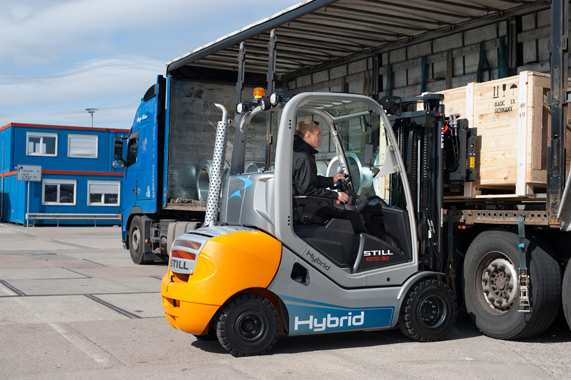
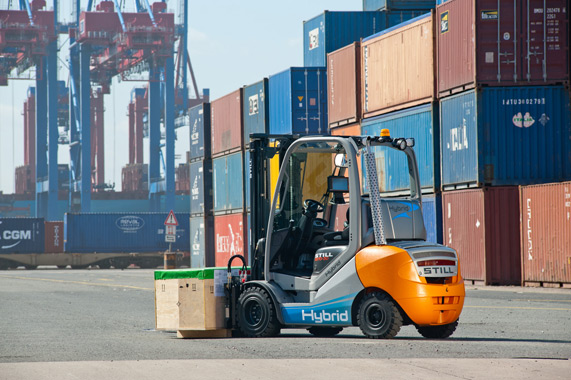
Evaluation
Pros & Cons+ Economical use of Energy
+ Spatial Characteristics in the Driver's Cabin
+ Functionality
– Preset Tilting Speed
– Starting Routine

